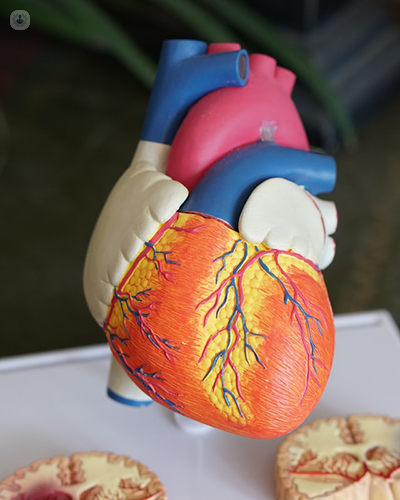An expert explains: How is coronary artery bypass grafting performed?
Escrito por:Narrowing of the coronary arteries can pose a serious risk to life if a blockage to the heart’s blood flow is not treated promptly. In this illuminating article, renowned consultant cardiac surgeon Mr George Asimakopoulos clearly explains when coronary artery bypass grafting is required and how the procedure is carries out. He also sheds light on the most common symptoms of coronary artery disease and what patients can expect from the recovery period following treatment.

What is coronary artery disease?
Coronary artery disease is the narrowing of one or more coronary arteries resulting in impaired blood supply to the heart muscle. The most common symptoms include chest tightness or pain (angina), which is often experienced in the jaw or left arm, and also shortness of breath. A sudden blockage of a coronary artery causes a heart attack, which is also known as a myocardial infarction.
How is coronary artery disease treated?
Coronary artery disease may be treated with the insertion of stents by a cardiologist or with coronary artery bypass grafting (CABG) by a heart surgeon. CABG utilises the patient’s own arteries and veins to bypass the narrowing in the coronary arteries and improve blood supply. The procedure has been proven to be very effective in treating angina and in preventing heart attacks. The results of large clinical trials are allowing us to distinguish between patients should have stents and those who are best served by CABG.
How is coronary artery bypass grafting performed?
CABG is a surgical procedure where the surgeon gains access to the heart by opening the chest bone, also known as the sternum. The surgeon subsequently mobilises one or both internal mammary arteries, which are located on either side of the chest bone, before connecting them to the coronary arteries. Other options include the radial artery of the forearm or veins removed from the leg.
CABG can be performed with the support of the heart-lung machine, also known as on-pump CABG, or on the beating heart or off-pump. Both techniques are well established and give excellent results when performed by an experienced team. There is evidence that the off-pump technique is often preferable for certain high risk procedures while certain other patients should be operated on-pump.
What is the recovery period like after coronary artery bypass grafting?
Following CABG, the average hospital stay is six days, followed by a few weeks of recovery at home. The patient is subsequently followed up by their surgeon, their cardiology team and their GP. Despite its complexity, CABG is safe for the majority of patients and is associated with an excellent long term prognosis.
Mr Asimakopoulos is a highly esteemed cardiac surgeon with over twenty five years of experience. If you are interested in learning more about Mr Asimakopoulos or wish to book a consultation with him, you can do so by visiting his Top Doctors profile.


